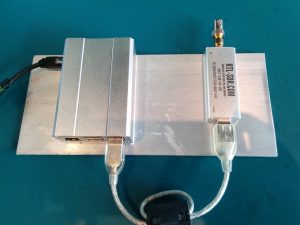FM (VK2RMB)
All our FM voice repeaters use vertically polarised, omni-directional antennas at approximately 220 Meters above sea level.
2m
- Status is operational
- Transmits on 146.875 MHz, with a 91.5Hz CTCSS tone
- Receives on 146.275 MHz; a CTCSS tone is not required.
- Timeout is 3 minutes. As a minimum, before you transmit again, please wait for the “beep”, which indicates that the timer has been reset. (There is no need to wait for the repeater to stop transmitting.)
However, it is more polite to leave a longer pause after you hear the beep, before you transmit again. This makes it easier for other stations to break in and join the conversation.
Repeater audio stream
If you don’t have a radio handy, or you’re out of range, you can listen using the player below:
This audio stream is provided courtesy of Broadcastify. More details on the feed, including how to listen on your phone or tablet, and how to set up your own audio stream, can be found here.
70cm (FM and P25)
- Status is operational
- Transmits on 438.175 MHz
- Receives on 433.175 MHz and requires a 91.5 Hz CTCSS tone for access, for both FM and P25 modes.
- Timeout is 3 minutes. Please refer to the 2m FM repeater section above, for comments about repeater timeouts.
- For P25 mode, NAC is 293
6m
- Status is off air for overhaul
- Transmits on 53.675 MHz
- Receives on 52.675 MHz
10m
- Status is under construction (has been for a long time – don’t hold your breath!)
- Transmits on 29.120 MHz
- Receives on 29.120 MHz
P25 Digital
Our 70cm FM repeater also does P25 – see above for details
DMR (VK2RMB)
- Status is operational
- Network ID is 505235
- Transmits on 438.4000 MHz
- Receives on 433.0000 MHz
- Uses Standard Colour Code, Time Slots and Talk Groups
More information at the VK DMR web site
D-STAR
The Society is one of two Sydney radio clubs chosen by the WIA to host the ICOM D-STAR repeaters. Since September 2009, our D-STAR repeaters, VK2RWN, have been operational on 2m and 70cm. We’re currently considering various options for 23cm.
Status, March 2020: both repeaters have recently had hardware and software upgrades; they are temporarily off-air for a site relocation; in the process, the callsign and frequencies may also change. Current network status of VK2RWN.
2m (VK2RWN C)
- Status: off air pending relocation
- Transmits on 146.96250 MHz DV
- Receives on 146.3625 MHz
70cm (VK2RWN B)
- Status: off air pending relocation and frequency change
- Transmits on 438.400 MHz DV
- Receives on 433.000 MHz
See also:
APRS Gateways
- VK2MB-1 is our main 2m APRS IGate, operating on the standard APRS frequency of 145.175 MHz. See Mal VKTMF’s notes below.
- VK2MB-2 is our second 2m APRS IGate, also on 145.175 MHz. This one is intended to improve APRS coverage in some of the more “shaded” parts of the peninsula. More info.
- VK2MB-6 is our 30m HF Receive-only IGate, listening on 10147.6 kHz; see New 30m HF APRS IGate and Working Bee, 2021-03-06 for more information.
New IGate installed 21-Dec-2016 by Mal VK2TMF
Our favourite simplex chat frequencies
80 metres: 3670 kHz
40 metres: 7085 kHz
2 metres: 147.4750 MHz (600 kHz above VK2RMB 2 metre repeater output frequency)
NEW: LiveATC YSSY/YSBK aviation audio stream
We are currently testing a new audio streaming service, monitoring traffic transiting from Sydney’s Bankstown Airport (YSBK) to Sydney Harbour via the Parramatta River. This lane is called R405 (A & B), the radio frequency used for the calls is 120.80 Mhz AM. We are hoping the range will also include the Victor One lane covering the coast from the Sydney Heads to Stanwell Park. The stream is only active during daylight hours.
https://www.liveatc.net/hlisten.php?mount=ysbk_r405a&icao=ysbk
Information on the R405 lane is provide by the Seaplane Pilots Association of Australia
https://seaplanes.org.au/resources/Documents/SPAA-R405-a.pdf
Equipment used is a Raspberry Pi 3B+, USB soundcard dongle, Yaesu VR-500 scanner (overkill, but has zebra display, so best used in a box!). The aerial is shared with the VK2MB-1 APRS iGate with no perceivable performance degradation.






[…] net takes place every Wednesday evening from 8pm, on the club 2m repeater, VK2RMB on 146.875MHz, with a -600kHz offset. Call in and stay in […]
[…] club’s two D-STAR repeaters have been off air for some time, during which they have undergone maintenance and software […]
Hi, I’ve registered on VK2RWN Terrey Hills – North Sydney. VK1RWN Site is down. I’m wondering what the turn around for receipt of rego email is? Or how to contact the administrator to discuss.
Thanks
Drew
VK1FLEX
Hi Drew,
Not sure if you’ve had a reply via other channels. If not, the person to contact is Terry VK3BMX at dstar22@tpg.com.au.
73 Richard VK2SKY
[…] Instead, join the weekly radio net every Wednesday at 8pm, on the VK2RMB 2m FM repeater. […]
The 70cm DMR repeater VK2RMB on test is working well to a handheld in Woolloomooloo, King Cross and the City.
Matt
VK2FLY
The VK2RWN D-STAR repeater dashboard is now accessible via the link:
https://vk2rwn.gw.ircddb.net/
[…] VK2RMB Repeaters […]
[…] a HAM!Contact InfoEvents and MeetingsLatest Blog PostsMWRS FAQVK2RMB Repeaters Society […]
will you be using 2m and 70m for JOTA? this year
Last year D-STAR worked quite well, one of the highlights being contacts to a scout group up in Queensland. Provided there is an operator present who can drive the radio, I would suggest we do it again this year.